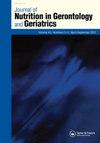长期护理居民营养不良的患病率或风险:四种工具的比较
Q3 Medicine
Journal of Nutrition in Gerontology and Geriatrics
Pub Date : 2019-07-23
DOI:10.1080/21551197.2019.1640165
引用次数: 24
摘要
确定营养不良风险或营养不良长期护理(LTC)的理想工具是难以捉摸的。本研究使用四种工具比较了来自加拿大32个LTC家庭的638名居民营养不良或风险分类的患病率、与居民风险因素的关联以及敏感性(SE)和特异性(SP):迷你营养评估简短表格(MNA-SF);患者主观全局评估(PG-SGA)全局分类评定与Pt-Global webtool以及interRAI长期护理机构的营养不良诱因。MNA-SF患病率最高(53.7%),InterRAI患病率最低(28.9%),而PG-SGA Global Category Rating(44%)高于Pt-Global webtool(33.4%)。除少数例外,工具始终与常驻协变量相关。与所有其他工具相比,PG-SGA Global Category Rating显示出最佳的敏感性和特异性。需要进一步的工作来确定该工具在LTC居民中的预测有效性。本文章由计算机程序翻译,如有差异,请以英文原文为准。
Prevalence of Malnutrition or Risk in Residents in Long Term Care: Comparison of Four Tools
Abstract The ideal tool for determination of malnutrition risk or malnutrition in long term care (LTC) is elusive. This study compares prevalence, association with resident risk factors and sensitivity (SE) and specificity (SP) of malnutrition or risk categorization in 638 residents from 32 LTC homes in Canada using four tools: the Mini-Nutritional Assessment Short Form (MNA-SF); Patient-Generated Subjective Global Assessment (PG-SGA) Global Category Rating and the Pt-Global webtool; and the interRAI Long Term Care Facility undernutrition trigger. Prevalence was most common with MNA-SF (53.7%) and lowest with InterRAI (28.9%), while the PG-SGA Global Category Rating (44%) was higher than the Pt-Global webtool (33.4%). Tools were consistently associated with resident covariates with few exceptions. The PG-SGA Global Category Rating demonstrated the best sensitivity and specificity when compared to all other tools. Further work to determine the predictive validity of this tool in LTC residents is required.
求助全文
通过发布文献求助,成功后即可免费获取论文全文。
去求助
来源期刊

Journal of Nutrition in Gerontology and Geriatrics
Nursing-Nutrition and Dietetics
CiteScore
2.20
自引率
0.00%
发文量
13
期刊介绍:
The Journal of Nutrition in Gerontology and Geriatrics publishes original research studies that are directly relevant to clinical and community nutrition issues that affect older adults. Epidemiologic and community-based studies are suitable for JNE, as are well-controlled clinical trials of preventive and therapeutic nutritional interventions. The Journal of Nutrition in Gerontology and Geriatrics invites papers on a broad array of topics in the nutrition and aging field, including but not limited to studies of: preventive nutrition, nutritional interventions for chronic disease, aging effects on nutritional requirements, nutritional status and dietary intake behaviors, nutritional frailty and functional status, usefulness of supplements, programmatic interventions, transitions in care and long term care, and community nutrition issues.
 求助内容:
求助内容: 应助结果提醒方式:
应助结果提醒方式:


